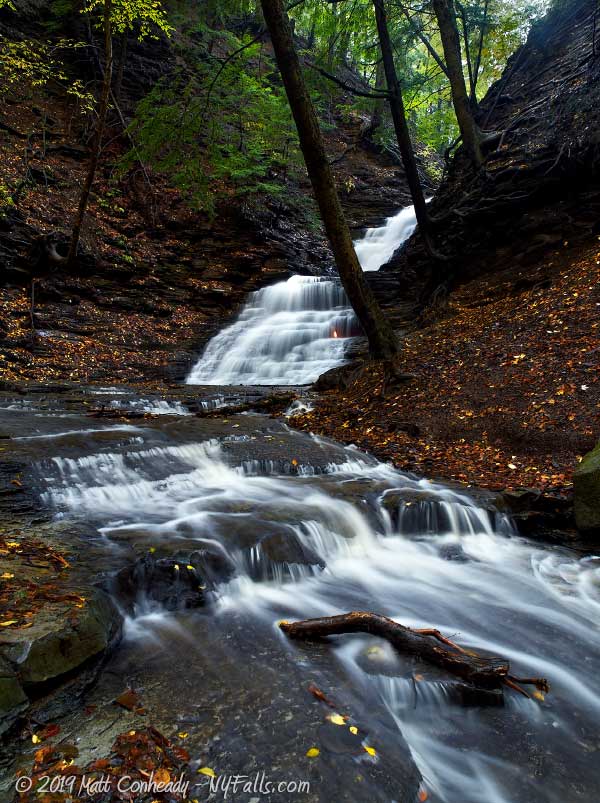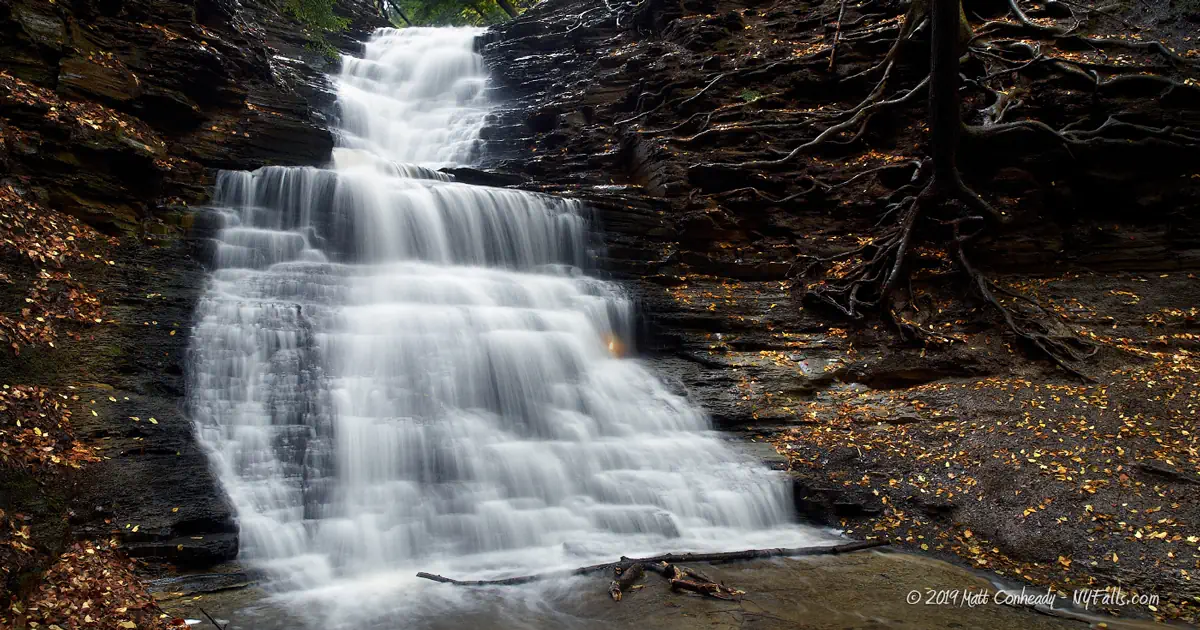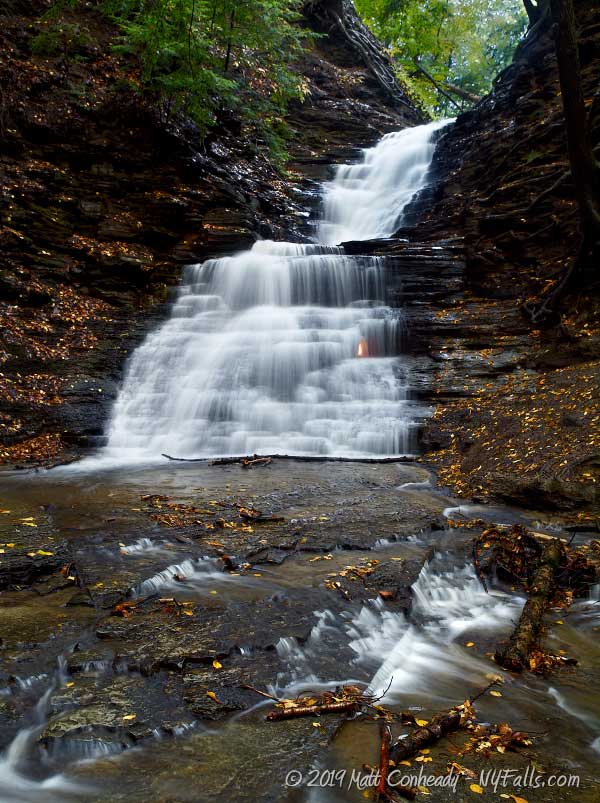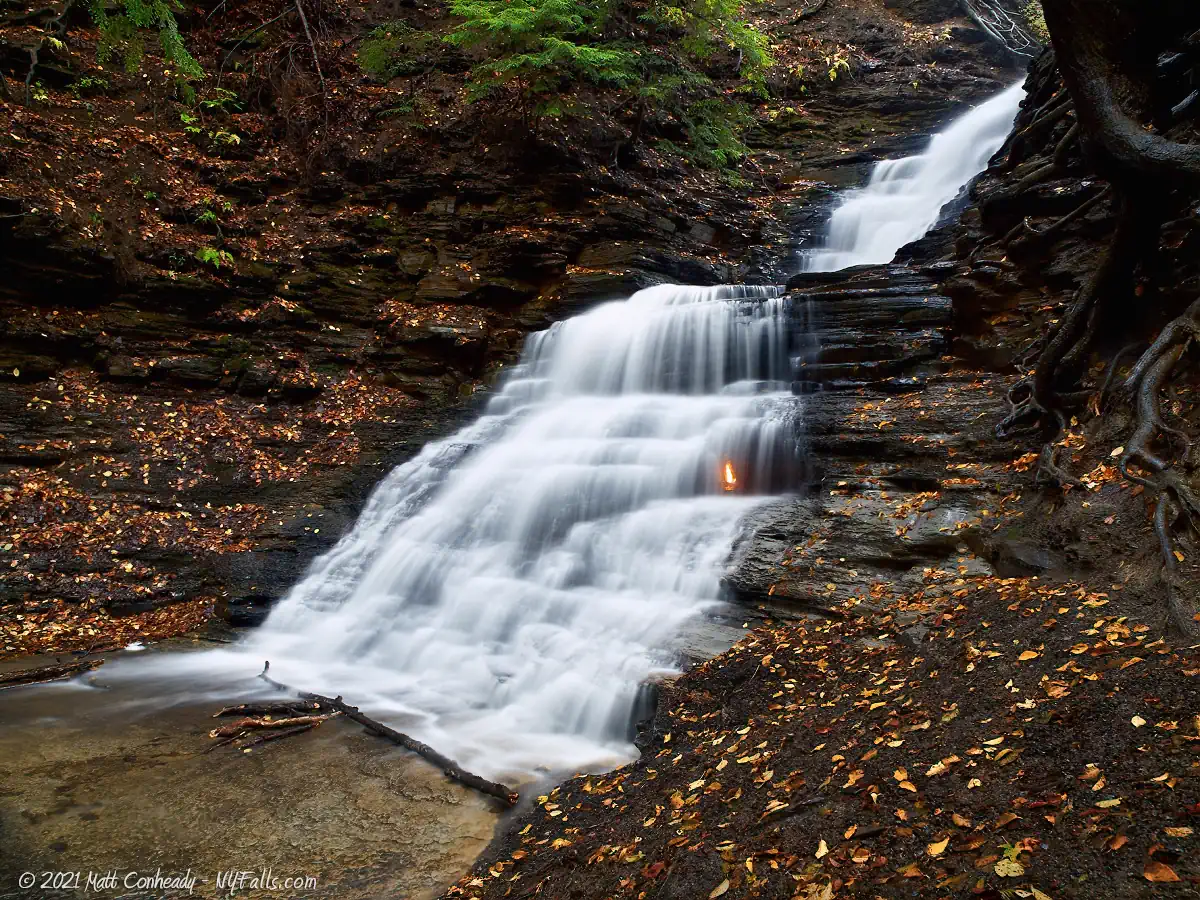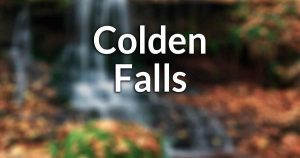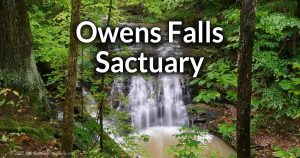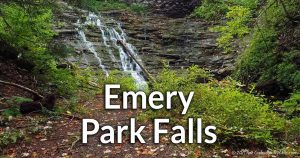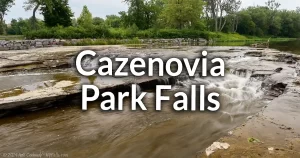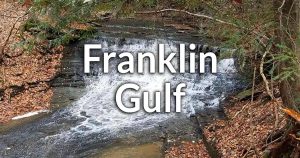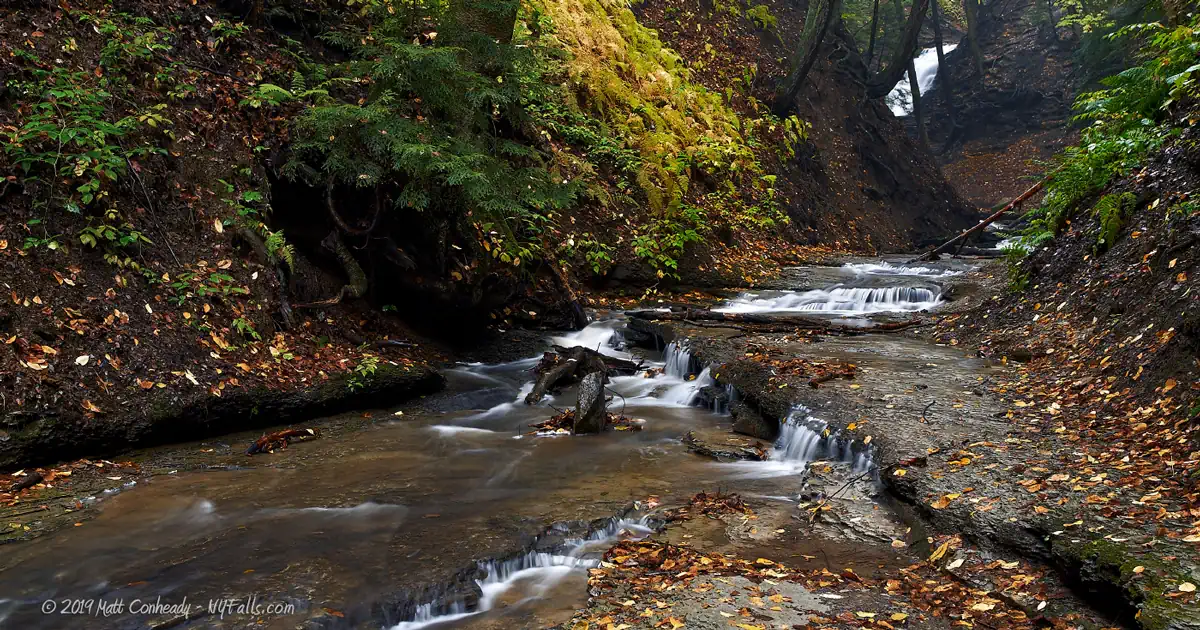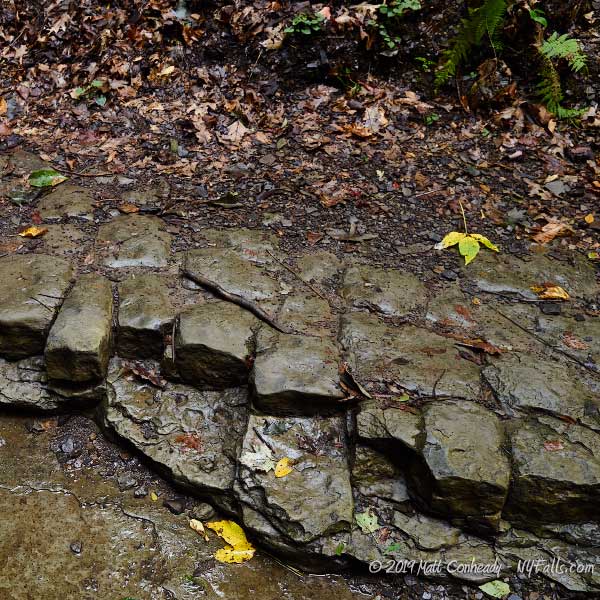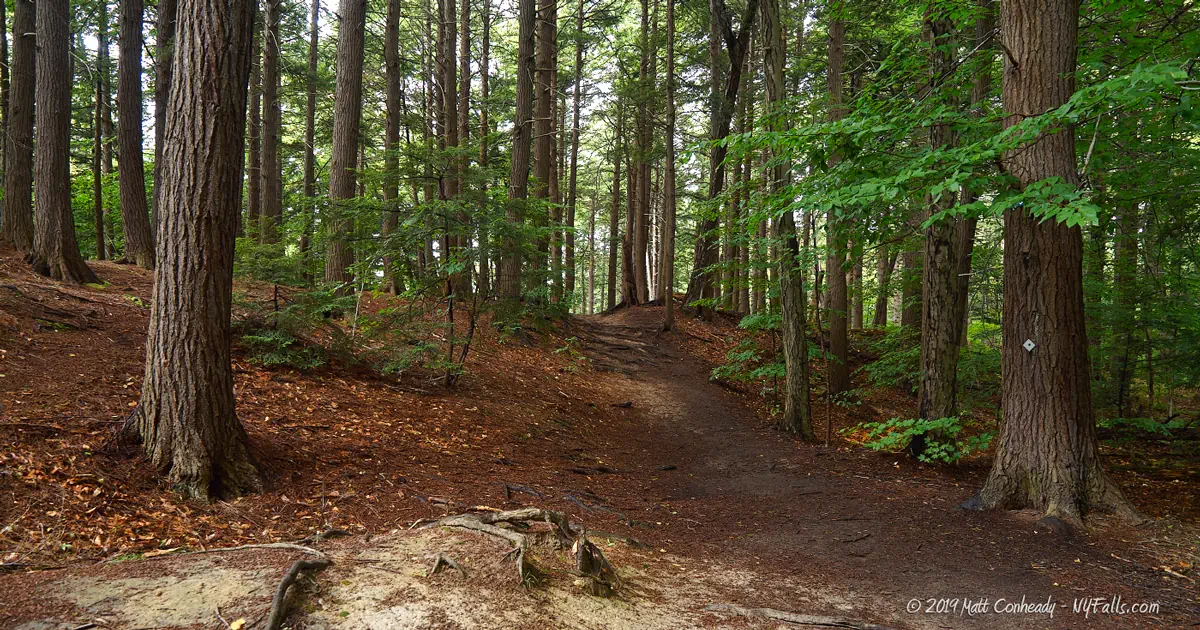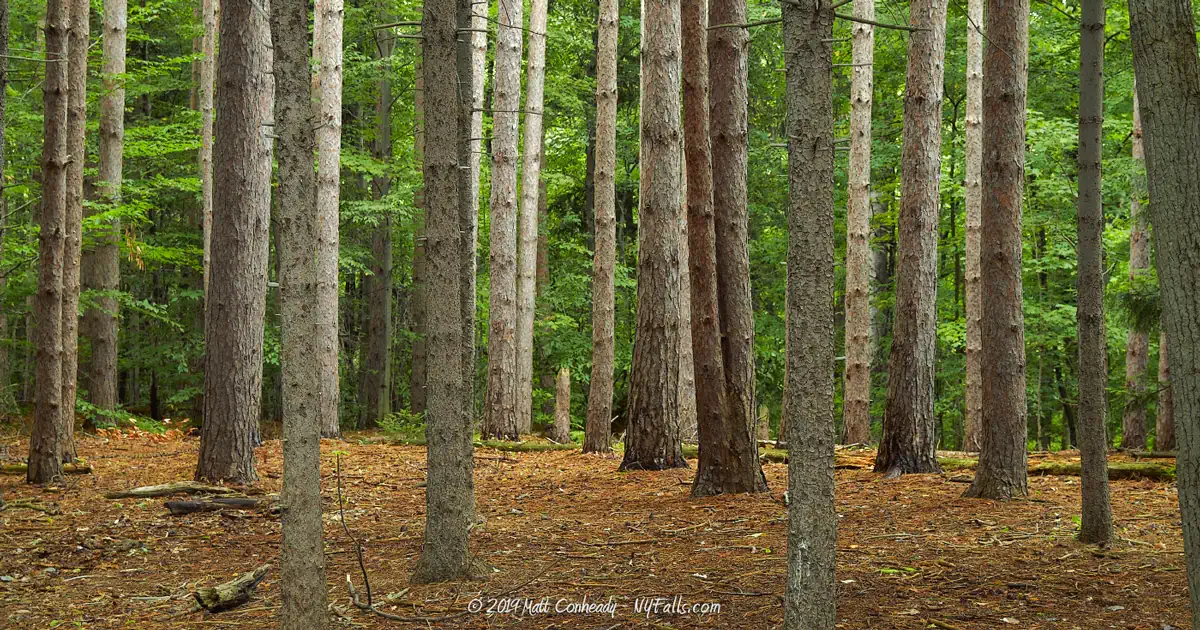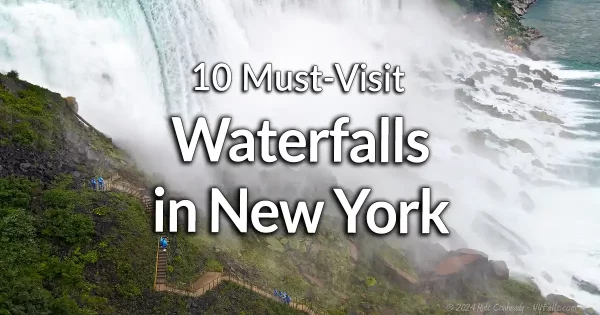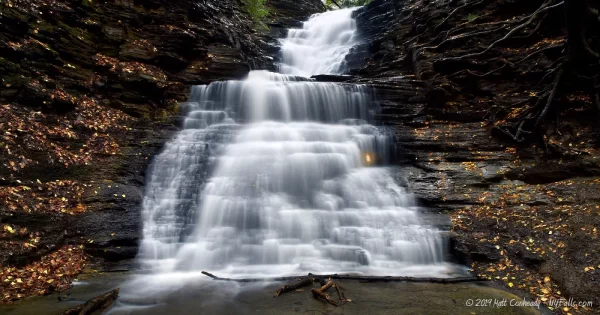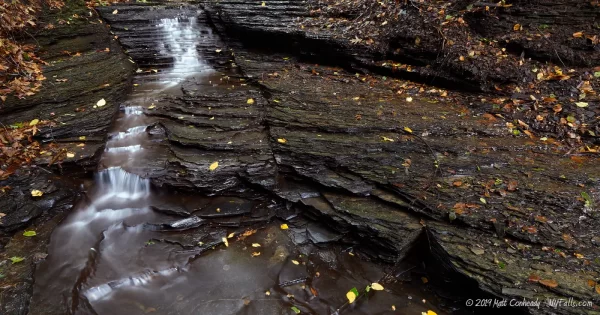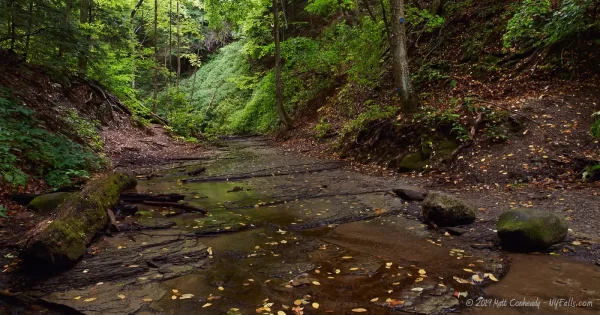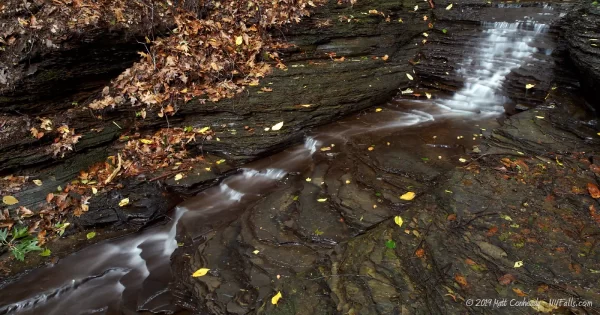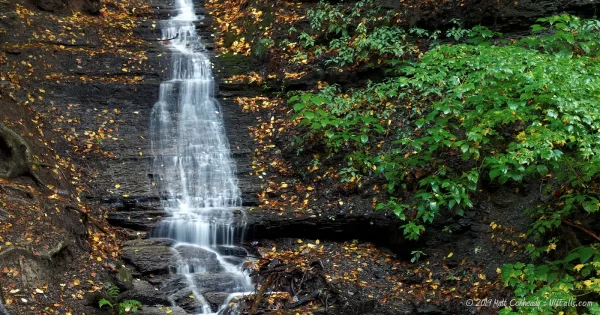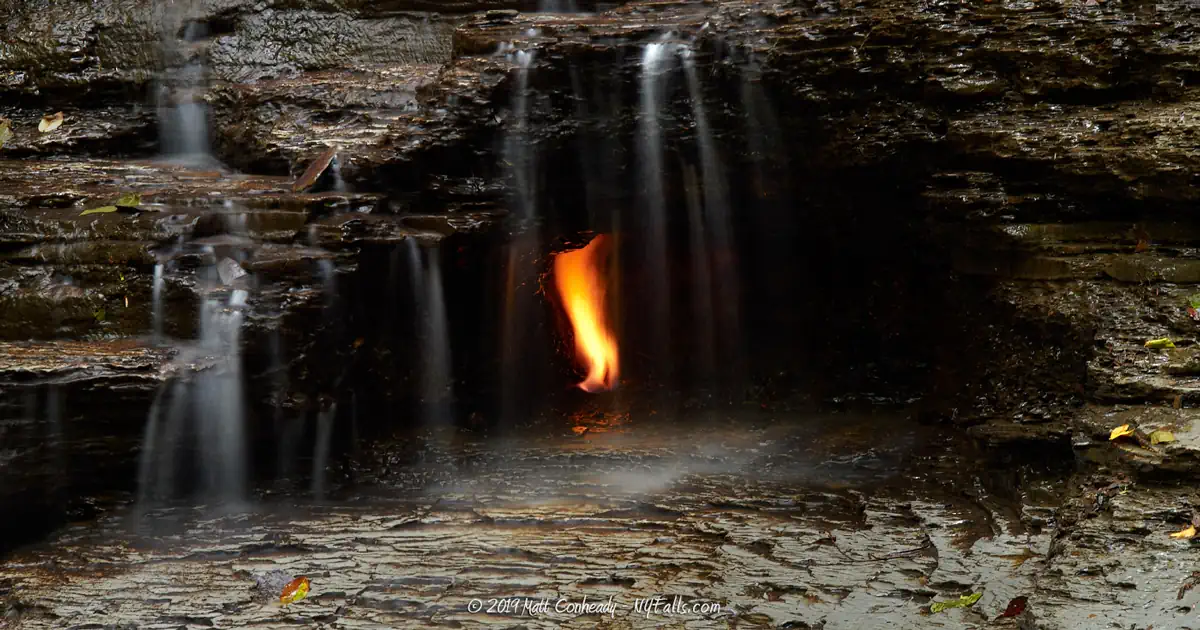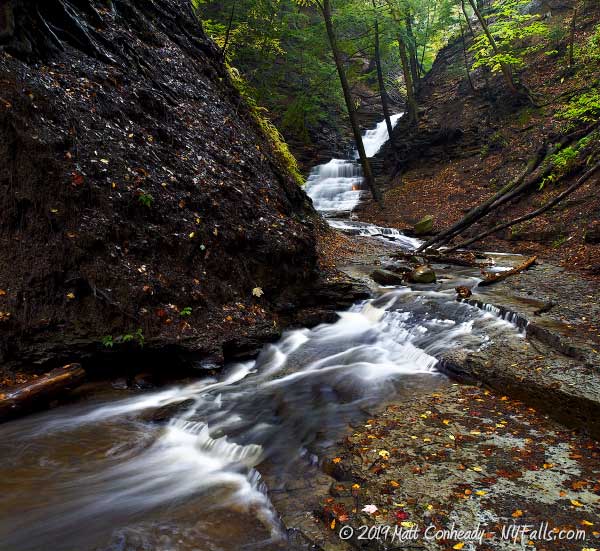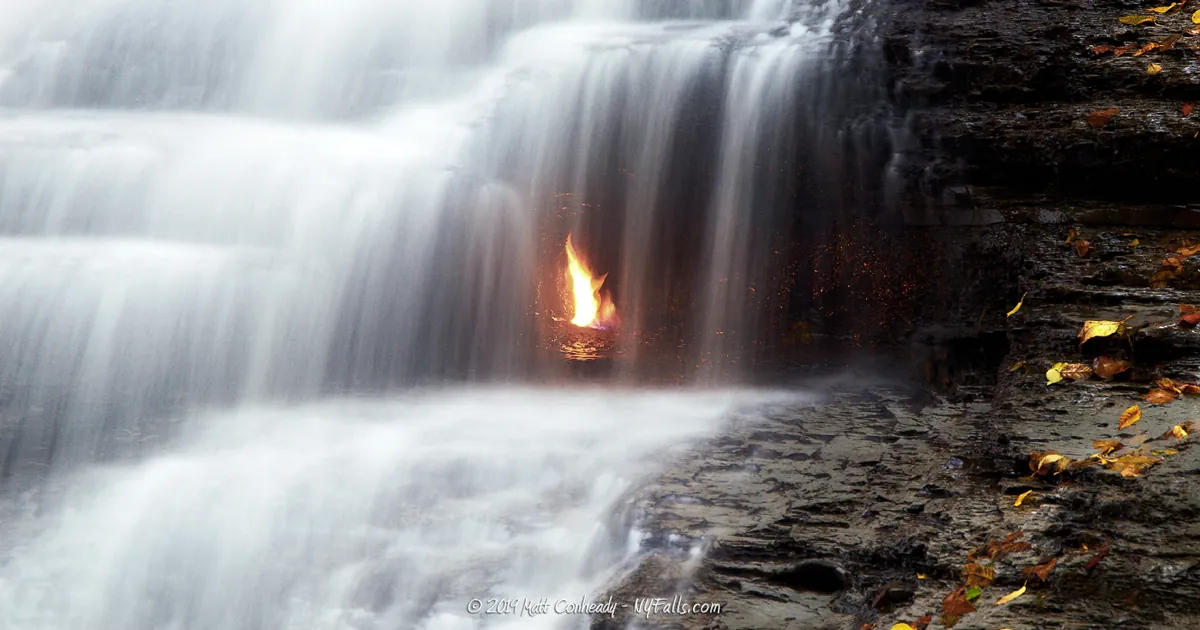Eternal Flame Falls
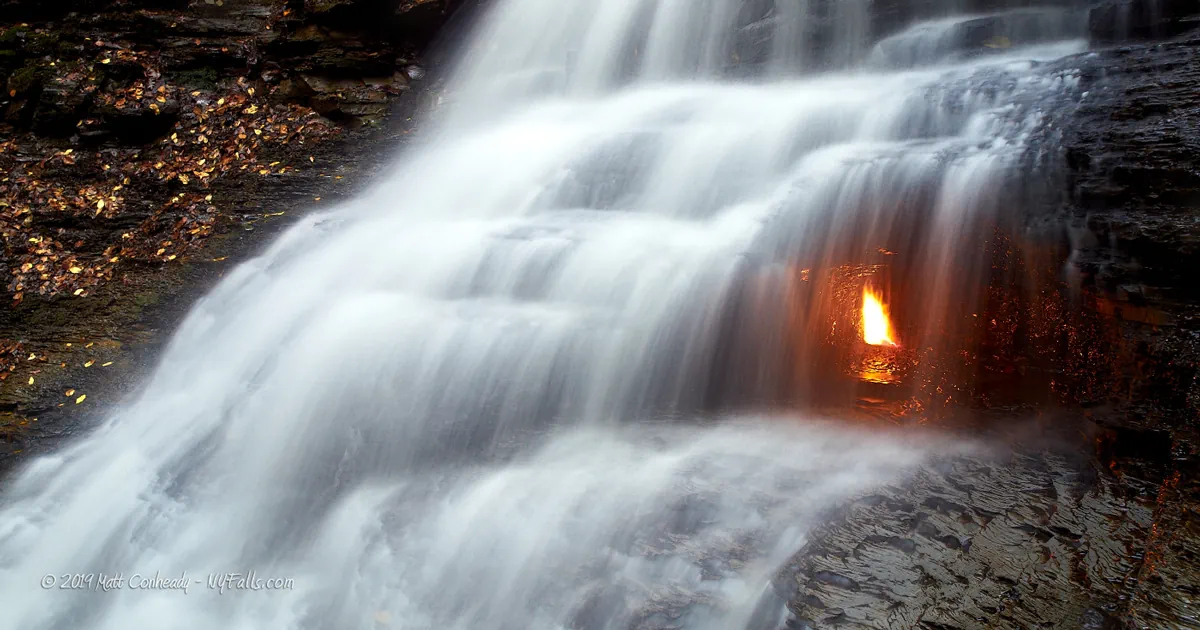
Location: In Chestnut Ridge Park; just outside of North Boston; Town of Orchard Park; Erie County; New York.
Maps: Google Map; Topographic; Park map with trails; Interactive map.
GPS Coordinates:
- Parking and Trailhead: (N 42.69993 / W 78.75238)
- Eternal Flame Falls: (N 42.70158 / W 78.75113)
- Roadside parking: (N 42.70012 / W 78.75255)
Directions: Take I90 to US-219 and follow it south for 11 miles. Take the NY-391 exit toward Boston/Hamburg and turn left onto Boston State Rd. Take the 3rd left onto NY-277 (Herman Hill Rd.) and follow it for just over a mile and a half. It becomes Boston Ridge Rd. Take a sharp left on Seufert Rd and park immediately on the right.
Or use Google Maps.
Parking: Park alongside Seufert Rd. Spaces for roughly a dozen cars. Alternatively you can enter the park from the main entrance, and park in the lot there, but this guide doesn’t cover that route.

Weather
Information / Accessibility / Accommodations
Number of falls: 1. There are two additonal, smaller falls in the gully, but not worth going into detail on.
Size/Types: Eternal Flame Falls is a 30 ft high cascade in two segments. The top is a narrow cascade of nearly 8 ft high. The second tier spreads out more than twice the width as it cascades over shale. A small grotto to the right houses a natural gas spring that can be ignited to create a flame of 4-8 inches in height. Two small cascades (that really aren’t worth the effort to get to) can be found upstream from Eternal Flame.
Best time to visit: Early spring. It’s most likely going to be dry in warm weather. Winter has dangerously slippery conditions. Early spring may have high waterflow that will make it difficult to make your way upstream.
Flow: Seasonal. It is usually dry from late spring through fall.
Waterway: Shale Creek, which starts across Boston Ridge Rd in a small farm pond and joins Eighteenmile Creek 2 miles to the west of the park. Eighteenmile Creek empties into Lake Erie.
Time: An hour or more for the trail loop.
Seasons/Hours: Open year-round, daily, from 7am to 9pm. Parking on the roadside is only available until 7pm. Note that visitors are no longer allowed to hike up the gorge to the falls.
Admission: Free.
Handicap accessibility: No.
Pets: Allowed if on leash. Due to the danger involved with this trail, we highly recommend not bringing your pets. This is not only for your pet’s safety, but for the safety of fellow hikers. Seriously – the poor pets get hurt on hikes like this–be responsible.
Accommodations: On the side that has the falls, covered in this guide, are just trails and signs.
Chestnut Ridge Park itself has several accommodations, such as a snack bar at the “Casino,” but you need to drive to the main entrance. Bicycling, Disc Golf, Electric Car Charging Station, Hiking Trails, Picnic Area, Picnicking, Playgrounds, Skiing: Cross-Country, Skiing: Downhill, Sledding, Snowmobiling, Snowshoeing, Softball, Tennis, Toboggan Chutes.
The closest restrooms are a 40 minute hike to the north.
Description
AKA: Chestnut Ridge Falls (but you are lame if you call it that!)
Chestnut Ridge Park is situated on 1213 acres of the northern face of a series of hills sandwiched between the Eighteenmile Creek and West Branch Cazenovia Creek valleys in Erie County. This sloping terrain of glacial sand, shale, and limestone rock has a complex, natural drainage system that is comprised of several immature creeks. The most notable being Shale Creek, the host to Eternal Flame Falls.
The park itself is a superb summer family destination; containing miles of hiking trails, cycling paths, several playing fields, tennis courts, and a wealth of picnic facilities and shelters. In winter, the hilly terrain draws crowds in for skiing, sledding and snowshoeing. Eternal Flame Falls, despite being located within the park boundaries, is off on the fringe, away from the crowds, and most directly accessible from a trail that begins on the southern edge of the park.
The path leading down to Shale Creek and Eternal Flame Falls snakes through mixed hardwood forest on a sandy glacial terrain, and passes a beautiful Hemlock grove as it winds around to the bottom. The descent can get a bit muddy and filled with obstacles, as erosion has exposed the sandy earth as well as a large quantity of exposed roots. Once at the creek, visitors must walk upstream to get to the falls. A few downed trees can get in the way, and if the falls are flowing, you will most likely get your feet wet, but overall the hike upstream is uneventful.
As you approach the falls, the smell of rotten-egg-like natural gas fills the air within the ravine. This is the result of seepage from layers of organically-rich Hanover Shale. This roughly 90 ft-thick rock layer consists of alternating strata of brittle, gray and black shale that was deposited during the Devonian Period, 416 to 359 million years ago. The gasses produced during the decomposition of the organics within the rock deposits are under pressure and push out through cracks and loose layers within the rock. One large fissure is located right within Eternal Flame Falls, in a small grotto that protects the gas seepage from the falling water and any wind, enabling it to sustain a flame when lit. Two other, smaller seepages within the grotto can be lit, although they can’t hold a flame as large or as long as the primary flame. There are several other gas seepages, or springs, around the falls, but locating them can be tricky and lighting them often impossible. Some are located underneath the pool below the falls, and can be seen as bubbles rising up from the bedrock below.
Eternal Flame Falls is highly dependent on rainfall and melt water. It is usually only flowing in early spring, or after long bouts of heavy rain. It reaches 30 ft high, cascading over sloping shale in two segments. The top is a narrow cascade over limestone, nearly 8 ft high. The second tier spreads out more than twice the width as it cascades over shale. A small grotto, 5 ft up from the creek bed, to the right houses the natural gas spring that can be ignited to create a flame of 4-8 inches in height. When flow is high, the water pours over the grotto, covering the flame and diffusing the light like a lampshade.
Eternal Flame Falls is truly one of the most unique waterfalls in the state, possibly the country, but the muddy landscape, unpredictable flow, and significant amount of trash within the ravine detract from the experience. Overall if you are in western New York, during the wet season, and have an hour to spare, be sure to check this one out.
Nearby Waterfalls
History
The Late Devonian Period and its muddy and organic-rich shallow oceans deposited the shale rock layers that are responsible for the gas deposits that power the flame. We are not sure of when the deposits were discovered by man, and when specifically Eternal Flame was first lit. We suspect it was during the economic boom in the 1920s when Chestnut Ridge Park was under heavy development as a county park. It was during this time that the park saw crowds far beyond the busiest summer days we have now.
The first settlers in the Town of Orchard Park arrived in October of 1803 and founded what would become a sizable settlement of Quakers, some of the first of which were the Potter family in 1809. They build a house and farm, where records indicate they had up to 150 apple trees. Originally known as Potter’s Corners, it took on the name Orchard Park around the 1880s, drawing inspiration from the Orchard-like appearance. For a time the township it was in was known as East Hamburg, but experienced too many post office conflicts with the Erie County town of Hamburg, and it too changed its name to Orchard Park in 1935. The hills that contain the park are named for the chestnut forest that once covered them. In the early 1900s nearly all the chestnut trees were decimated by blight. The ridges and gullies in the park remained undeveloped and the park was founded in 1926, containing 350 acers (1213 acres today).
Hiking / Walking Trails
Caution! The creek-walk is off-limits and park police do patrol the park and ask people to leave. There have recently been a bunch of accidents resulting in injury. The creek is slippery and not exactly a breeze for a lot of people. If you make this hike, you do so at your own risk. If you get hurt doing some Instagram BS, slip and fall, and ruin it for the rest of us, then you get what you deserve. Either way, it’s your choice and I take no responsibility for your stupidity.
Difficulty: Difficult, due to muddy and unstable terrain, steep trails, and unavoidable creek walking. Plan to get wet if water if flowing.
Distance: Just over a half mile one way. Unless you get lost, like I did, then it will be considerably more.
Markings: Blue rectangular blazes on the trees.
Description: Chestnut Ridge Park contains numerous trails, but here we are concentrating on the main trail that leads directly to Eternal Flame Falls.
From the parking area and the park trail map, head into the woods (this part of the trail is an old road) and soon you will come across a kiosk containing a description of the trail and falls. Near this kiosk is a downed and rotting redwood tree, a species unusual for this region. This marks the trail-head to Eternal Flame Falls, follow the blue rectangular wooden blocks nailed to the trees.
About a tenth of a mile in, the trail will dip down and you will have to cross Shale Creek (this is upstream from the falls). At this point, you could creek walk downstream to see two small cascades and reach the top of Eternal Flame Falls. To get to the base of the falls, cross the creek and continue up the dirt trail. Soon you will pass a hemlock grove on your right and be able to hear the falls to the left (if it is flowing). Continue along the trail as it begins to dip down into the ravine.
The mud trail begins to show heavy signs of erosion as the elevation decreases. Watch out for exposed roots. At about 0.2 miles, the trail reaches the creek bed and switches back. At this point the blue blaze trail ends and you now have to creek walk the last half of the way. There are no waterfalls to climb along the way, but there are some downed trees you will have to scramble over.
Reach the falls at about 0.52 miles. Turn around and follow the same trail to get back to the road.
Maps: Interactive map; Park/trail map.
Eternal Flame Falls Interactive Map
10 Must-Visit Waterfalls In New York State
A selection of the most popular and accessible waterfalls around the State of New York. From Niagara Falls in Western NY to Kaaterskill Falls in the Hudson Valley Region.
Eternal Flame Falls Media
Interesting Stuff
Fracking
“Fracking” or Hydraulic Fracturing is a mining technique used to forcefully extract natural gas deposits from layers of shale rock. In New York State the Marcellus Shale layers are the targets of the energy industry. This range of rock is energy rich, making it a highly profitable venture. The Hanover layer of shale that creates the Eternal Flame is not so appealing at this time. Fracking is the subject of much controversy in NY, Pennsylvania, Ohio, and West Virginia where these deposits exist. On one hand, the revenue this energy source can create is massive. On the other, the unnatural pressure and chemicals pumped into the rock can be damaging to the environment, both above and below ground. There have been recent cases of groundwater contamination in fracking-active regions of Pennsylvania. Most importantly, despite the surge fracking can give to the economy of New York, there is no quick and easy fix for the type of damage mining can do to the environment, especially if it occurs in a widespread system of aquifers that carry our groundwater. It may be years before a problem is detected, and then decades before it can be contained and rehabilitated. Is that a risk that should be taken? It’s up to NY lawmakers to decide.
Photography Tips
Is it flowing?
- There’s nothing more disappointing than making the hike down into the gorge then scrambling upstream to get to the falls, only to find it dry. 10 minutes into the hike you will cross Shale Creek upstream from the falls. The rule of thumb: if you can cross the creek here and remain dry, then the falls will at best be a trickle.
Got a light?
- Although the gas spring is 100% natural, the flame isn’t. Bring a lighter to get it going. Be careful, it usually ignites with a pop.
Silky Water Effect
- To get that smooth cotton-candy look to the falls, you need to use a Neutral Density (ND) filter on your lens. The ND filter will block some of the light from entering the lens without altering the color, and thus allow your shutter to stay open longer. This blurs the water and creates a soft white gloss to the foamy areas of the falls. Check out the article for the all the details.
More tips
- See the Articles for more photography tips.
Who to Contact
Erie County Department Of Parks, Recreation & Forestry
Room 1359
95 Franklin Street
Buffalo, NY 14202
Phone: (716) 858-8355
erie.gov/parks/
10 Must-Visit Waterfalls Around Ithaca, NY
A selection of the most popular and accessible waterfalls around Ithaca in the Finger Lakes Region of New York.



